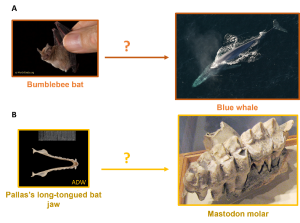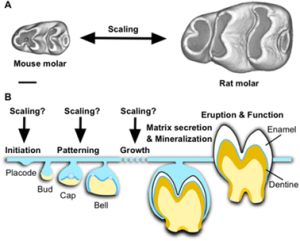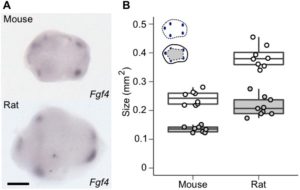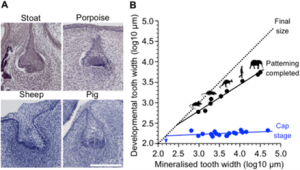The developmental basis for scaling of mammalian tooth size
Preprint posted on 3 December 2022 https://www.biorxiv.org/content/10.1101/2022.12.03.518730v1.full
Article now published in Proceedings of the National Academy of Sciences at http://dx.doi.org/10.1073/pnas.2300374120
Categories: developmental biology, evolutionary biology
Background
From the teeny-tiny 30 mm long bumblebee bat to the giant 30 m long blue whale, mammals are extremely diverse in term of body size (Fig. 1). Despite this huge diversity in size, their overall body plan and many of their organs look the same, just at a different scale: some species look like miniature versions of others, and their organs are scaled to the organism body size. While many body parts exhibit such scaling in mammals, we still have a limited understating of the mechanisms by which species scale their organs while maintaining their overall organization and form. When does scaling happen during development? Are organs patterned first and then grow in size, or are they larger since the very first steps of their development? Are certain developmental steps more important than others for scaling body parts? And finally, how are bigger organs patterned with more cells and tissue?

A: Mammalian sizes range from the tiny bumblebee bat to the blue whale
B: Molar scaling: from the tiny nectar bat to the enormous mastodon
To study some of these questions, the authors chose the first lower molar as a model system. Molars can be found in small and big mammals (e.g. bats, mice, elephants, opossums, dolphins, tigers), including model organisms (1). Thanks to the extensive body of research performed on mice molars (2), the different steps of tooth development, as well as the gene regulatory network controlling these steps are well understood, making it timely to study their variation in other species. Finally, thanks to museum collections rich in extant and extinct species, the ability to culture molars in vitro, and the existence of a computation model of tooth development, the results found in model organisms can be expanded to other mammals.
Key findings
To study the mechanisms behind scaling, the authors compared the development of the mouse and rat first lower molars, by combining in situ hybridization and 3D reconstruction from micro-computerised tomography (μCT) scans (Fig. 2). Mouse and rat molars exhibit a similar organization but rat molars are twice as big as mice molars.
The patterning of molars is similar between species of different sizes They found that tooth size starts to slightly diverge early during development, at the beginning of tooth formation and morphogenesis (from the “Bud” to “Cap” stages). Later, during the formation of the crown and the cusps, this difference increases despite both species developing at the same rate. Together, these results demonstrate that scaling happens during the whole patterning of teeth, right after the initiation stage, implying a scaling of the patterning process itself. In other words, the patterning of the molar remains similar in both species, independent of the amount of tissue to pattern.

Tooth size expansion and patterning can be explained by a higher expression of IGF1
To investigate the mechanisms by which tooth patterning scales, the authors used a combination of in situ hybridization, RNAseq, tooth culture experiments, and mouse mutants to respectively: follow the patterning of key structures of the teeth such as the cusps, identify candidate genes that could trigger the differences between mouse and rat development, and test these candidates functionally by adding or blocking specific pathways during tooth development in vitro and in vivo (Fig. 3).

They found that tooth size expansion can be explained by a higher expression of IGF1 in rats compared to mice. When IGF1 is overexpressed in tooth cultures, not only the molar gets bigger, but the cusps become more widely spread. Further experiments and computer simulations revealed that IGF1 stimulates cell proliferation, explaining the tooth larger size, but inhibits cusp patterning by inhibiting the formation of cusps signaling centers, explaining how the patterning scales in larger developmental fields.
Scaling of teeth is controlled by IGF1 in other mammals
Finally, to extend these results to other mammals that possess a similar molar organization, the authors examined the differences between the “Cap” stage (in which morphological differences become noticeable) and the adult first lower molar in 14 mammalian species of varying final body sizes (Fig. 4). Interestingly, they found that while the tooth germ size remains relatively stable between species at the cap stage, later stages tend to scale up with the final tooth size, confirming the scaling of the patterning. This beautiful result has implications regarding the absolute size that a tooth germ can reach: by extrapolating the results of the “Cap” stage in multiple species, the authors concluded that there is a minimum limit for tooth size in mammals and larger teeth are achieved by a progressive increase of growth during pattering. As organs generally scale with body size, the authors suggest that similar scaling of patterning could happen in many other organs, potentially driven by IGF1.

Conclusion – what I liked about this preprint
This work uses a well-known model system – the mammalian molar – to assess a fundamental, unresolved, question about organ size evolution. I particularly liked the elegant demonstrations mixing integrative approaches that allow the extension of the results from model organisms to multi-species comparisons. I also loved that this preprint tackles evolutionary questions from a developmental point of view to find general rules (here scaling) that explain the evolution of all organisms.
References
1. Berkovitz, B. K. B. & Shellis, R. P. The Teeth of Mammalian Vertebrates. (Academic Press, 2018).
2. Catón, J. & Tucker, A. S. Current knowledge of tooth development: patterning and mineralization of the murine dentition. J. Anat. 214, 502–515 (2009).
Posted on: 18 January 2023 , updated on: 13 June 2023
doi: https://doi.org/10.1242/prelights.33508
Read preprintSign up to customise the site to your preferences and to receive alerts
Register hereAlso in the developmental biology category:
Temporal constraints on enhancer usage shape the regulation of limb gene transcription
OGT prevents DNA demethylation and suppresses the expression of transposable elements in heterochromatin by restraining TET activity genome-wide
Actin polymerization drives lumen formation in a human epiblast model
Also in the evolutionary biology category:
A long non-coding RNA at the cortex locus controls adaptive colouration in butterflies
AND
The ivory lncRNA regulates seasonal color patterns in buckeye butterflies
AND
A micro-RNA drives a 100-million-year adaptive evolution of melanic patterns in butterflies and moths
A complex Plasmodium falciparum cryptotype circulating at low frequency across the African continent
Evolution of tandem repeats in putative CSP to enhance its function: A recent and exclusive event in Plasmodium vivax in India
preLists in the developmental biology category:
GfE/ DSDB meeting 2024
This preList highlights the preprints discussed at the 2024 joint German and Dutch developmental biology societies meeting that took place in March 2024 in Osnabrück, Germany.
| List by | Joyce Yu |
‘In preprints’ from Development 2022-2023
A list of the preprints featured in Development's 'In preprints' articles between 2022-2023
| List by | Alex Eve, Katherine Brown |
preLights peer support – preprints of interest
This is a preprint repository to organise the preprints and preLights covered through the 'preLights peer support' initiative.
| List by | preLights peer support |
The Society for Developmental Biology 82nd Annual Meeting
This preList is made up of the preprints discussed during the Society for Developmental Biology 82nd Annual Meeting that took place in Chicago in July 2023.
| List by | Joyce Yu, Katherine Brown |
CSHL 87th Symposium: Stem Cells
Preprints mentioned by speakers at the #CSHLsymp23
| List by | Alex Eve |
Journal of Cell Science meeting ‘Imaging Cell Dynamics’
This preList highlights the preprints discussed at the JCS meeting 'Imaging Cell Dynamics'. The meeting was held from 14 - 17 May 2023 in Lisbon, Portugal and was organised by Erika Holzbaur, Jennifer Lippincott-Schwartz, Rob Parton and Michael Way.
| List by | Helen Zenner |
9th International Symposium on the Biology of Vertebrate Sex Determination
This preList contains preprints discussed during the 9th International Symposium on the Biology of Vertebrate Sex Determination. This conference was held in Kona, Hawaii from April 17th to 21st 2023.
| List by | Martin Estermann |
Alumni picks – preLights 5th Birthday
This preList contains preprints that were picked and highlighted by preLights Alumni - an initiative that was set up to mark preLights 5th birthday. More entries will follow throughout February and March 2023.
| List by | Sergio Menchero et al. |
CellBio 2022 – An ASCB/EMBO Meeting
This preLists features preprints that were discussed and presented during the CellBio 2022 meeting in Washington, DC in December 2022.
| List by | Nadja Hümpfer et al. |
2nd Conference of the Visegrád Group Society for Developmental Biology
Preprints from the 2nd Conference of the Visegrád Group Society for Developmental Biology (2-5 September, 2021, Szeged, Hungary)
| List by | Nándor Lipták |
Fibroblasts
The advances in fibroblast biology preList explores the recent discoveries and preprints of the fibroblast world. Get ready to immerse yourself with this list created for fibroblasts aficionados and lovers, and beyond. Here, my goal is to include preprints of fibroblast biology, heterogeneity, fate, extracellular matrix, behavior, topography, single-cell atlases, spatial transcriptomics, and their matrix!
| List by | Osvaldo Contreras |
EMBL Synthetic Morphogenesis: From Gene Circuits to Tissue Architecture (2021)
A list of preprints mentioned at the #EESmorphoG virtual meeting in 2021.
| List by | Alex Eve |
EMBL Conference: From functional genomics to systems biology
Preprints presented at the virtual EMBL conference "from functional genomics and systems biology", 16-19 November 2020
| List by | Jesus Victorino |
Single Cell Biology 2020
A list of preprints mentioned at the Wellcome Genome Campus Single Cell Biology 2020 meeting.
| List by | Alex Eve |
Society for Developmental Biology 79th Annual Meeting
Preprints at SDB 2020
| List by | Irepan Salvador-Martinez, Martin Estermann |
FENS 2020
A collection of preprints presented during the virtual meeting of the Federation of European Neuroscience Societies (FENS) in 2020
| List by | Ana Dorrego-Rivas |
Planar Cell Polarity – PCP
This preList contains preprints about the latest findings on Planar Cell Polarity (PCP) in various model organisms at the molecular, cellular and tissue levels.
| List by | Ana Dorrego-Rivas |
Cell Polarity
Recent research from the field of cell polarity is summarized in this list of preprints. It comprises of studies focusing on various forms of cell polarity ranging from epithelial polarity, planar cell polarity to front-to-rear polarity.
| List by | Yamini Ravichandran |
TAGC 2020
Preprints recently presented at the virtual Allied Genetics Conference, April 22-26, 2020. #TAGC20
| List by | Maiko Kitaoka et al. |
3D Gastruloids
A curated list of preprints related to Gastruloids (in vitro models of early development obtained by 3D aggregation of embryonic cells). Updated until July 2021.
| List by | Paul Gerald L. Sanchez and Stefano Vianello |
ASCB EMBO Annual Meeting 2019
A collection of preprints presented at the 2019 ASCB EMBO Meeting in Washington, DC (December 7-11)
| List by | Madhuja Samaddar et al. |
EDBC Alicante 2019
Preprints presented at the European Developmental Biology Congress (EDBC) in Alicante, October 23-26 2019.
| List by | Sergio Menchero et al. |
EMBL Seeing is Believing – Imaging the Molecular Processes of Life
Preprints discussed at the 2019 edition of Seeing is Believing, at EMBL Heidelberg from the 9th-12th October 2019
| List by | Dey Lab |
SDB 78th Annual Meeting 2019
A curation of the preprints presented at the SDB meeting in Boston, July 26-30 2019. The preList will be updated throughout the duration of the meeting.
| List by | Alex Eve |
Lung Disease and Regeneration
This preprint list compiles highlights from the field of lung biology.
| List by | Rob Hynds |
Young Embryologist Network Conference 2019
Preprints presented at the Young Embryologist Network 2019 conference, 13 May, The Francis Crick Institute, London
| List by | Alex Eve |
Pattern formation during development
The aim of this preList is to integrate results about the mechanisms that govern patterning during development, from genes implicated in the processes to theoritical models of pattern formation in nature.
| List by | Alexa Sadier |
BSCB/BSDB Annual Meeting 2019
Preprints presented at the BSCB/BSDB Annual Meeting 2019
| List by | Dey Lab |
Zebrafish immunology
A compilation of cutting-edge research that uses the zebrafish as a model system to elucidate novel immunological mechanisms in health and disease.
| List by | Shikha Nayar |
Also in the evolutionary biology category:
‘In preprints’ from Development 2022-2023
A list of the preprints featured in Development's 'In preprints' articles between 2022-2023
| List by | Alex Eve, Katherine Brown |
preLights peer support – preprints of interest
This is a preprint repository to organise the preprints and preLights covered through the 'preLights peer support' initiative.
| List by | preLights peer support |
EMBO | EMBL Symposium: The organism and its environment
This preList contains preprints discussed during the 'EMBO | EMBL Symposium: The organism and its environment', organised at EMBL Heidelberg, Germany (May 2023).
| List by | Girish Kale |
9th International Symposium on the Biology of Vertebrate Sex Determination
This preList contains preprints discussed during the 9th International Symposium on the Biology of Vertebrate Sex Determination. This conference was held in Kona, Hawaii from April 17th to 21st 2023.
| List by | Martin Estermann |
EMBL Synthetic Morphogenesis: From Gene Circuits to Tissue Architecture (2021)
A list of preprints mentioned at the #EESmorphoG virtual meeting in 2021.
| List by | Alex Eve |
Planar Cell Polarity – PCP
This preList contains preprints about the latest findings on Planar Cell Polarity (PCP) in various model organisms at the molecular, cellular and tissue levels.
| List by | Ana Dorrego-Rivas |
TAGC 2020
Preprints recently presented at the virtual Allied Genetics Conference, April 22-26, 2020. #TAGC20
| List by | Maiko Kitaoka et al. |
ECFG15 – Fungal biology
Preprints presented at 15th European Conference on Fungal Genetics 17-20 February 2020 Rome
| List by | Hiral Shah |
COVID-19 / SARS-CoV-2 preprints
List of important preprints dealing with the ongoing coronavirus outbreak. See http://covidpreprints.com for additional resources and timeline, and https://connect.biorxiv.org/relate/content/181 for full list of bioRxiv and medRxiv preprints on this topic
| List by | Dey Lab, Zhang-He Goh |
1
SDB 78th Annual Meeting 2019
A curation of the preprints presented at the SDB meeting in Boston, July 26-30 2019. The preList will be updated throughout the duration of the meeting.
| List by | Alex Eve |
Pattern formation during development
The aim of this preList is to integrate results about the mechanisms that govern patterning during development, from genes implicated in the processes to theoritical models of pattern formation in nature.
| List by | Alexa Sadier |











 (No Ratings Yet)
(No Ratings Yet)